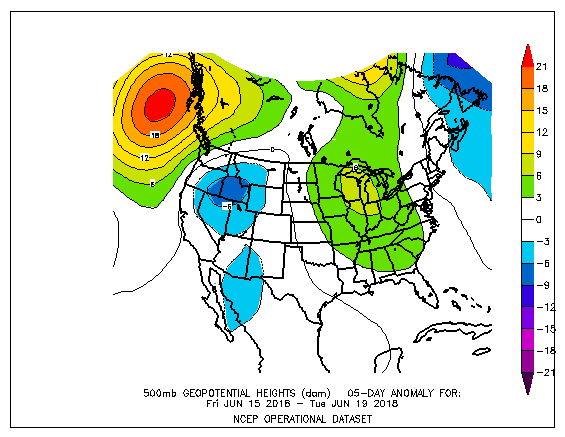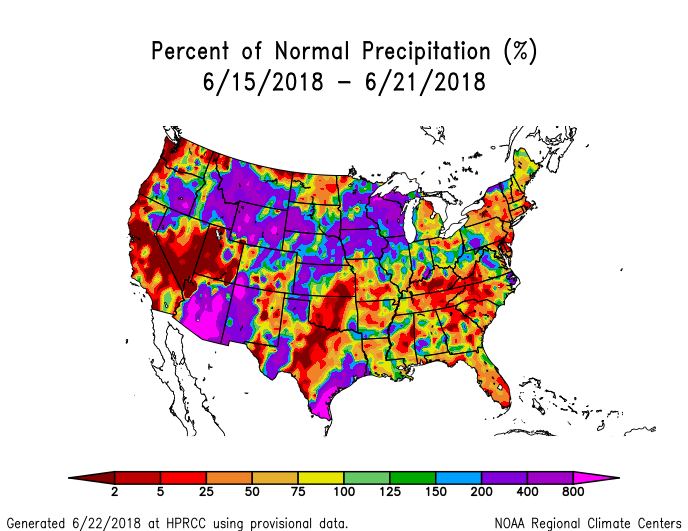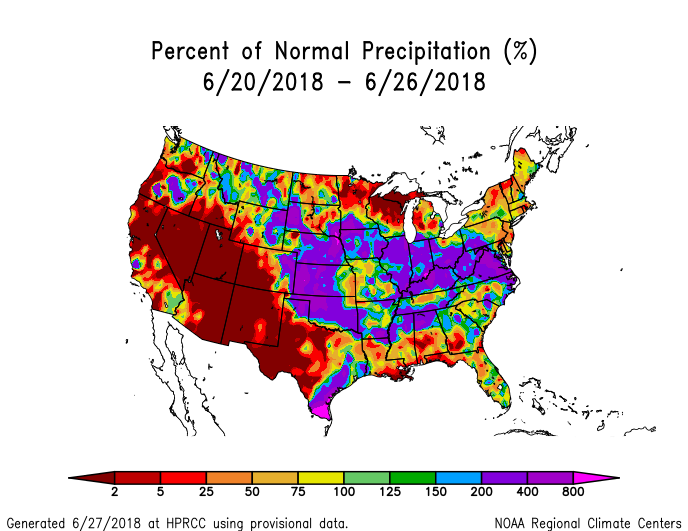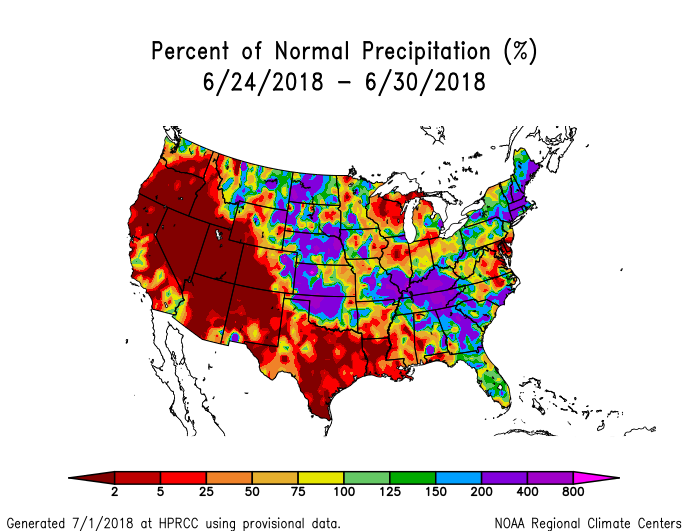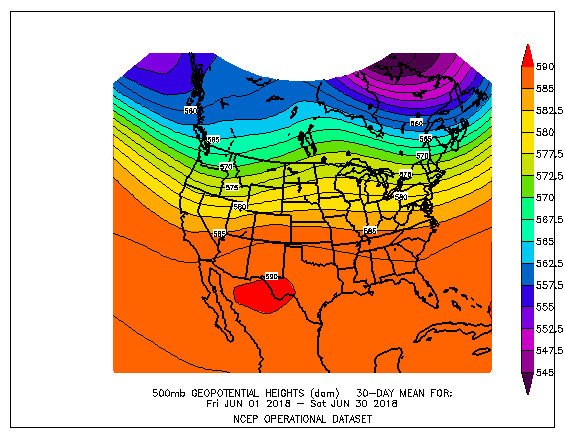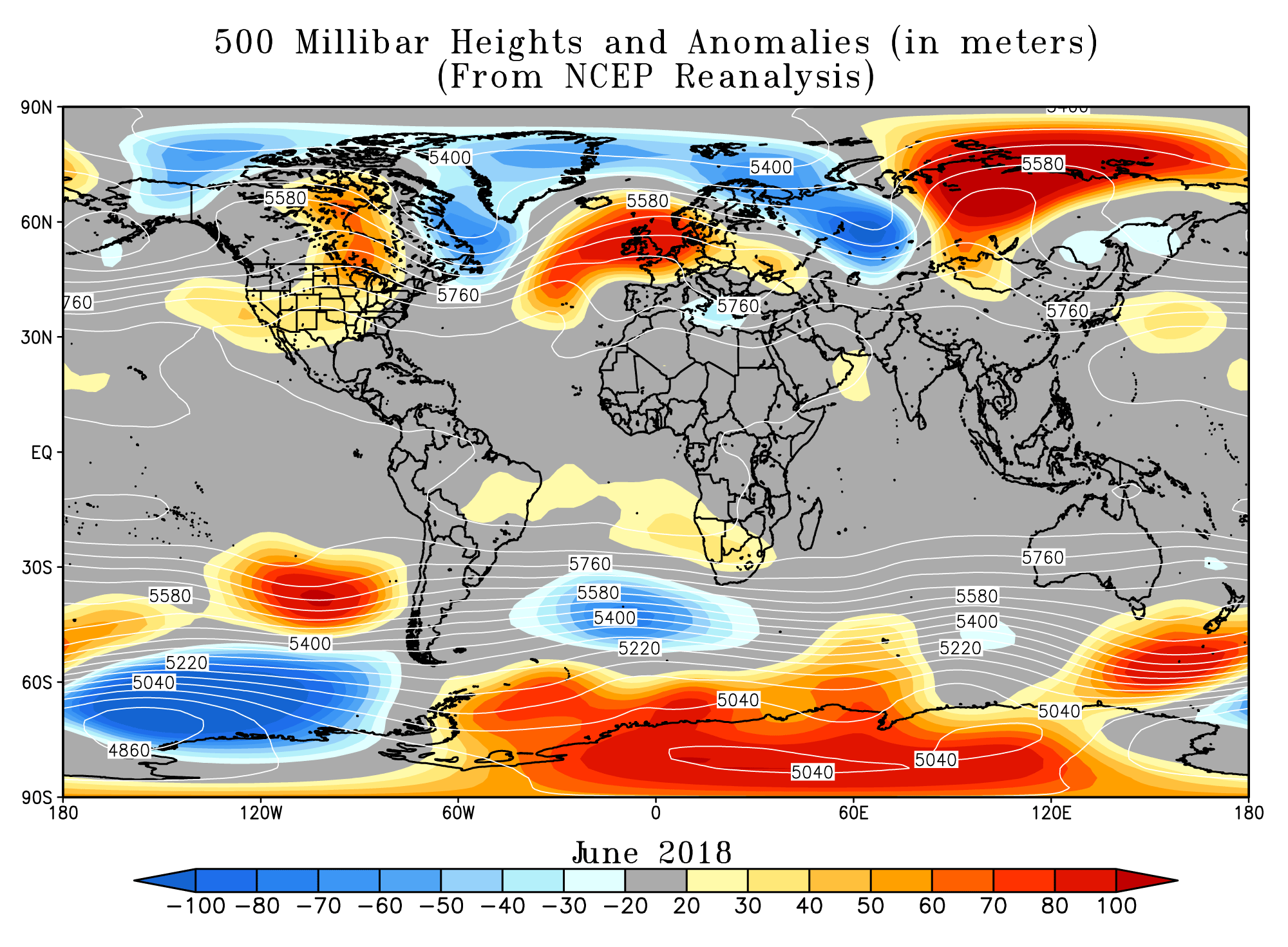Note: This Synoptic Discussion describes recent weather events and climate anomalies in relation to the phenomena that cause the weather. These phenomena include the jet stream, fronts and low pressure systems that bring precipitation, high pressure systems that bring dry weather, and the mechanisms which control these features — such as El Niño, La Niña, and other oceanic and atmospheric drivers (PNA, NAO, AO, and others). The report may contain more technical language than other components of the State of the Climate series.
Summary
The Earth's ocean-atmosphere system continued in an ENSO-neutral state during June 2018. Like the last several months, the upper-level circulation was quite active this month with shortwave ridges and troughs migrating through the jet stream flow over the contiguous United States (CONUS). But all of this activity took place within a bigger picture wherein a large broadscale/long-wave ridge dominated the overarching circulation over the CONUS. The ridge was responsible for another month of widespread much warmer-than-normal temperatures across the CONUS and, for the first half of the month, mostly drier-than-normal weather. Shortwave troughs and closed lows migrated across the northern edge of the broadscale ridge, bringing above-normal precipitation to parts of the country. This was especially the case during the second half of the month. During the middle of the month (June 15-21), tropical moisture from the remnants of Hurricane Bud brought above-normal precipitation to the Southwest, then further north when it became entrained within fronts associated with the upper lows, and another low pressure system drenched the Texas coast with flooding rains. For the month as a whole, the combination of these weather patterns left above-normal precipitation across parts of the Southwest, the Texas coast, and from the northern Rockies to the Mid-Atlantic states. The rains helped contract drought and abnormal dryness across parts of the Great Plains, Texas coast, and Midwest. But in the parts of the country missed by the troughs and lows, the ridge inhibited precipitation and enhanced evaporation, with below-normal precipitation occurring across much of the West and southern Plains to Lower and Mid-Mississippi Valley, and parts of the Southeast, Northeast, and Great Lakes. It was also drier than normal in parts of Puerto Rico and much of Hawaii. As a result, drought and abnormal dryness developed, expanded, or intensified in parts of the West, southern Plains to Mississippi Valley, Northeast, Puerto Rico, and Hawaii. Drought expansion outpaced contraction, so the national drought footprint grew a bit when compared to the beginning of June. The active troughs and lows, and their associated fronts, generated severe weather every day, but they were working against the broadscale ridge which generally inhibited severe weather, so the total (preliminary) tornado count was below the long-term average. The upper-level circulation, temperature, and precipitation anomaly patterns suggest that the atmospheric drivers originating in the North Pacific (WP, and maybe EP-NP) had an influence on the month's weather, with complications from Pacific tropical cyclones. See below for details.
Synoptic Discussion
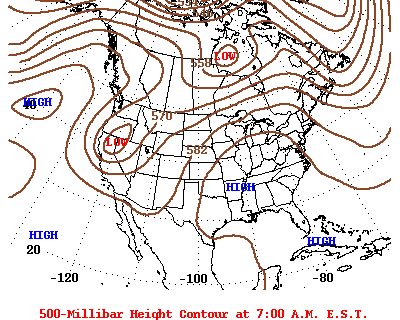 Animation of daily upper-level circulation for the month.
|
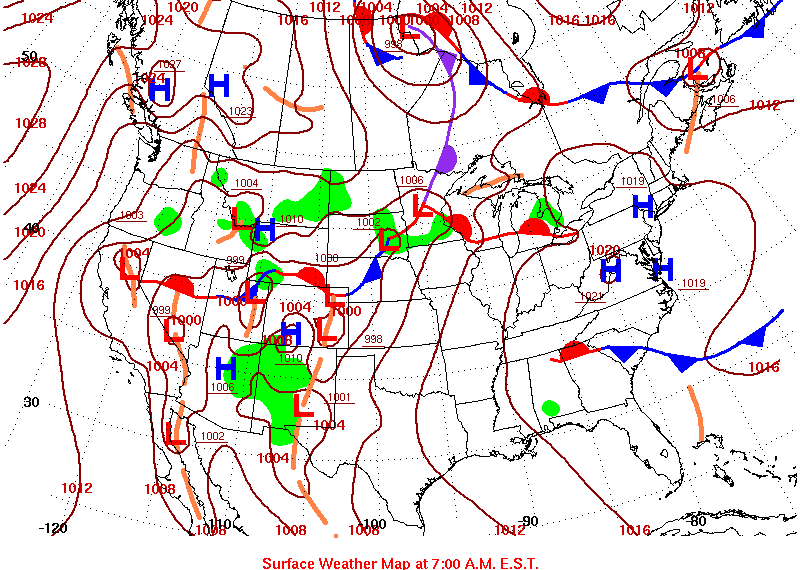 Animation of daily surface fronts and pressure systems for the month.
|
In the Northern Hemisphere, June marks the beginning of climatological summer which is the time of year when solar heating is at maximum with the high sun angle, arctic air masses are weakest, and the circumpolar vortex and jet stream have retreated far northward. Polar air masses influence the weather over the contiguous U.S. (CONUS) less, and the warm, dry subtropical high pressure belts dominate the weather.
A large, broadscale (long-wave) ridge dominated the upper-level circulation over the CONUS again during June. Like May, the ridge brought widespread unusually warm temperatures and, by itself, would have been responsible for widespread dry conditions as well. But strong short-wave troughs and closed lows from the Pacific, moving in the jet stream flow, skirted across the top of the ridge to bring areas of rain to parts of the West and Great Plains. A separate low pressure system brought excessive Gulf of Mexico moisture to the Texas coast. The result was an active upper-level circulation pattern that changed day-by-day throughout the month.
For this report, the June 2018 circulation was broken down into four periods, each characterized by specific weather phenomena, temperature anomalies, precipitation anomalies, and impacts.
During the first half of the month, the upper-level ridge dominated the CONUS while troughs moved across the northern states. The troughs dragged surface lows and fronts along with them, and some of the fronts reached the Gulf of Mexico coast, especially early in the month. But with the ridge inhibiting vertical motion in the atmosphere, the southern fronts weren't able to generate much precipitation, with only a few areas wetter than normal. With the storm track to the north, the fronts and lows brought a swath of above-normal precipitation to the northern Plains, Ohio Valley, and Mid-Atlantic region, and cooler-than-normal temperatures to parts of the Northwest and Northeast. But with the ridge dominating, temperatures were above-normal and precipitation below normal across most of the CONUS during June 1-14.
A large upper-level closed low moved into the Pacific Northwest and stalled out over the northern portion of the West during June 15-19. The low forced the ridge in the jet stream flow to intensify over the eastern CONUS. The upward vertical motion and cyclonic spin associated with the low resulted in above-normal precipitation across much of the Pacific Northwest to northern and central High Plains, with the rain and clouds keeping temperatures cooler than normal. The low created a southerly flow in the atmosphere which directed moisture from the remnants of Hurricane Bud into the Southwest and, later, into a front that was stalled out in the northern Plains. Bud's moisture brought above-normal precipitation to the drought-stricken Southwest and into the central to northern Plains and eastward. Other parts of the West did not benefit from Bud's and the upper low's moisture, so they were drier than normal. Meanwhile, a separate low pressure system meandered into the Texas Gulf coast, inundating much of the region with flooding rains as well as bringing below-normal temperatures. The precipitation didn't get very far inland, so much of central Texas to southeast Kansas was drier than normal. The ridge in the East kept temperatures warmer than normal from the Plains to East Coast and precipitation, for the most part, below normal.
The upper-level low finally moved out of the West and into the Plains then Northeast, and was followed by another strong closed low, during June 20-26. These upper-level lows, and their associated surface lows and fronts, brought above-normal precipitation to much of the central to northern Plains, Ohio to Tennessee Valleys, Southeast, and Northeast. As the lows moved out of the West, so did the rain, so much of the West was drier than normal. The weather systems did not reach the southern Plains, so this region also was drier than normal. The lows and fronts brought cooler-than-normal temperatures to the Northeast and parts of the Northwest to Ohio Valley, but warmer-than-normal temperatures still dominated across the Southwest to southern Plains.
The last four days of the month saw the closed low move to the east, allowing the ridge to again dominate the central part of the country, but another upper-level trough migrated into the Northwest as the month ended, forcing the entire pattern to shift eastward again.
The long-wave circulation pattern averaged across the entire month shows the dominance of the ridge over the central to eastern CONUS. The preference of troughs to congregate in the Northwest is reflected by a mean trough there as well as below-normal height anomalies. The dominance of the broadscale ridge is also reflected in the widespread above-normal height anomalies across most of the CONUS. The migration of the troughs and ridges across the northern half of the CONUS tended to mute the temperature anomalies during the last half of the month, although above-normal temperatures still tended to dominate for June 17-30. The broadscale ridge, or above-normal heights, or contracted circumpolar vortex, is strongly reflected in the much-above-normal temperatures when averaged across the month which covered much of the CONUS. Only the Northwest and Northeast were near to cooler than normal. The precipitation anomaly pattern for the month represented an additive result of the anomaly patterns for the various weeks — the areas that were much wetter than normal during one or more weeks showing up wet at the monthly time scale, and those areas (especially much of the West and central Texas to the Mississippi Valley) that were persistently dry every week, or which received a brief shot of above-normal precipitation, showing up as quite dry at the monthly scale. The circulation during this month was also reflected in severe weather, drought, and regional records.
- The extreme warmth was reflected in the statewide temperature ranks. In addition to being the third warmest June on record nationally, June 2018 ranked in the top ten warmest category for 15 states. These included the second warmest for New Mexico and third warmest for Colorado and Texas. About 44 percent of the CONUS was very warm (having June temperatures in the warmest tenth percentile of the historical record). The last eight Junes have had consistently much-warmer-than-normal temperatures nationally. A little less than a tenth (8 percent) of the CONUS was very wet (had June precipitation in the wettest tenth percentile of the historical record) and about the same amount (9 percent) was very dry (in the driest tenth of the historical record). The wet and dry conditions balanced each other out, nationally, giving the CONUS a June precipitation rank of 49th wettest. On a statewide basis, Iowa had the tenth wettest June in the 1895-2018 record, while Utah ranked sixth driest.
- When daily temperature records are examined, the extreme warmth overwhelmed the extreme cold. When integrated across the month, there were 5,402 record warm daily high (1,742) and low (3,660) temperature records. This was over five times the 986 record cold daily high (677) and low (309) temperature records.
- As noted earlier, June marks the beginning of the Northern Hemisphere climatological summer, the time of year when temperatures reach their peak seasonal warmth. The area-averaged temperature across the CONUS resulted in the third warmest June, nationally, in the 1895-2018 record. But the spatial pattern of temperature anomalies included some near- to cooler-than-normal temperatures in the heavily populated Northeast. When cooling degree days across the country are weighted by population, the result was a national REDTI (Residential Energy Demand Temperature Index) value for June 2018 that ranked as the ninth highest June REDTI in the 124-year record.
- Some of the precipitation fell on areas that were in drought at the beginning of the month and contracted drought and abnormal dryness, while other drought areas continued quite dry. Drought and abnormal dryness developed, expanded, or intensified in the Far West, central Rockies, southern Plains to Lower and Mid-Mississippi Valley, Northeast, and in parts of Puerto Rico and Hawaii, while it contracted in other parts of the Plains and parts of the Midwest. Expansion outweighed contraction, so at the national level drought expanded from 26.4 percent of the CONUS at the end of May to 29.7 percent of the CONUS at the end of June (from 22.1 percent to 24.8 percent for all of the U.S.). Dry conditions during the last one to nine months had set the stage for the widespread development of wildfires in the Southwest to southern Plains. June began with several large wildfires burning in the Southwest. By mid-month, large wildfires had developed across more of the West, with several burning across western Alaska. By the end of the month, most of the western states had large wildfires (wildfire maps for June 2, 13, 22, and 30), with several still burning in Alaska (Alaska wildfire maps for June 13, 18, 22, 25, and 30).
- The atmospheric circulation needed to create the instability and dynamics favorable for severe weather consists largely of a southwesterly flow across the central part of the CONUS, which funnels moist Gulf of Mexico air and its latent heat energy into the mix. Surface fronts provide additional atmospheric lifting. The changing direction of the circulation around surface lows and the upper-level troughs and lows above them adds spin to the rising air, which enhances the formation of tornadoes. This upper-level circulation pattern occurred frequently as the short-wave troughs and closed lows, and their associated surface fronts and lows, moved across the country, with most of the tornadoes occurring from the Great Plains to Northeast. Except for the 2nd, 4th, and 5th, when no tornadoes were reported, at least one tornado was sighted every day in June. But these systems and their dynamics were fighting against a broadscale upper-level pattern during June 2018 which supported descending air which acts to suppress severe weather. The net result of these competing forces was a total count (based on preliminary data) of 166 tornadoes, which is less than the June average of 243.
Typically tropical cyclone activity is enhanced in the Eastern North Pacific and inhibited in the North Atlantic during El Niños, and inhibited in the Eastern North Pacific and enhanced in the North Atlantic during La Niñas, due mostly to changes in vertical wind shear during the two extreme events. The relationship is unclear during ENSO-neutral events. The tropical Pacific Ocean was in an ENSO-neutral state during June 2018.
- The Atlantic hurricane season runs from June 1st through November 30th and no tropical cyclones formed in the North Atlantic during June.
- The Eastern North Pacific hurricane season runs from May 15th through November 30th. Five tropical cyclones and one tropical depression formed in the Eastern North Pacific basin during June 2018. Hurricane Aletta formed in early June and rapidly intensified, but stayed off the coast of Mexico. Hurricane Bud originated as a tropical depression on the 9th and tracked north off the Mexican coast before entering the Gulf of California, where it ended its life as a tropical depression around the 15th. However, moisture from the remnants of Bud was caught up in the southwesterly flow over the western CONUS and drawn into the drought-stricken Southwest, where it brought beneficial precipitation, and further north to become entrained in a frontal system. Tropical Storm Carlotta formed as Bud was dissipating, staying close to the Mexican coast and eventually degenerating into a remnant low over southwest Mexico. Tropical Storm Daniel originated on June 23rd off the coast of Mexico and veered out further into the Pacific before dissipating a few days later. Tropical Storm Emilia formed near the end of June off the coast of Mexico then veered off into the Pacific, lasting only a couple days. Tropical Depression 7-E formed on June 30th, intensifying into Hurricane Fabio in early July as it tracked further out to sea. All of these tropical systems formed essentially in the same area off the coast of Mexico, one after the other, and all except Bud and Carlotta were caught up in the easterly flow on the south side of the North Pacific High and steered west into the Pacific, away from land, where they weakened and dissipated.
- No tropical cyclones formed in, or moved into, the Central North Pacific.
- One tropical cyclone and three tropical disturbances developed in the western North Pacific in or near the U.S.-Affiliated Pacific Islands (USAPI) (Micronesia). Typhoon Maliksi formed as a tropical disturbance near the Republic of Palau in western Micronesia early in the month. The disturbance moved west of Micronesia into the Philippine Sea where it intensified into a tropical storm then eventually Typhoon Maliksi. Its remnants were transformed into an extratropical storm system at mid-month after it moved north past Japan into the westerlies, where it helped to develop and maintain the long-wave pattern over North America during the following two weeks. Tropical disturbances formed over western Micronesia at the beginning of June and the middle of June, and over eastern Micronesia near the end of June, but they did not develop into organized tropical cyclones. Several other tropical cyclones developed over waters west of the USAPI, including Typhoon Prapiroon and Tropical Storms Ewiniar, 07W, and Gaemi; these did not affect the USAPI.
|
The upper-level circulation pattern during June, when averaged for the month, consisted of a troughs in the West and along the East Coast, with a ridge and above-normal height anomalies across the middle of the CONUS stretching into the Southwest. |
|
June monthly precipitation was drier than normal across much of the West, the southern Plains to Mid and Lower Mississippi Valley, and parts of the Great Lakes, Northeast, and Southeast. The month was wetter than normal across parts of the Southwest and coastal Texas, much of the central to northern Plains, northern Rockies, western Great Lakes, Ohio Valley, and Mid-Atlantic region. Alaska was wetter than normal in the southwest to central regions, but drier than normal in places along the northern and eastern regions. Puerto Rico was wetter than normal in parts of the north to north central areas, and drier than normal elsewhere, especially in the south central region. Hawaii was mostly drier than normal. |
|
Monthly temperatures during June were warmer than normal across most of the CONUS, with only the Northeast and parts of the Northwest near to cooler than normal. Alaska was cooler than normal in the north and east, and warmer-than-normal in the west and south. |
|
Global Linkages: The upper-level (500-mb) circulation anomaly pattern over North America was part of a complex long-wave pattern that stretched across the Northern Hemisphere. East/west couplings of circulation anomalies are evident over Eurasia, the North Atlantic and Europe, and the North Atlantic and North America. The magnitude of the circulation anomalies over Eurasia indicates a pronounced degree of ridging and troughing there. The upper-level circulation and its anomalies are associated with the Sea Level Pressure (SLP) pattern and its anomalies which reflect the semi-permanent centers of action of SLP. The above- and below-normal upper-level height anomalies over parts of the North Pacific and North Atlantic appear to be associated with above- and below-normal SLP, respectively. The locations of these anomalies with respect to the long-term climatology suggests that the North Pacific High was stronger off the coast of the CONUS, and the Aleutian Low was a bit stronger along Alaska's Aleutian Chain (the Aleutian Low normally is weakest in the summer). A stronger Aleutian Low in combination with a stronger North Pacific High indicates a stronger storm track than usual, which can contribute to more powerful lows and storm systems coming into western North America. In the Atlantic, the locations of these anomalies with respect to the long-term climatology suggests a shift in the location of the North Atlantic High (or expansion of the North Atlantic High) towards Western Europe and a westward shift in the location of the Icelandic Low (the Icelandic Low normally is weakest in the summer). The pronounced ridging and troughing over northern Russia, and strong SLP anomalies, indicates an enhanced storm track in that region. During June 2018, North Pacific sea surface temperatures (SSTs) cooled in the western areas (along the Asian coast) and in the eastern tropical Pacific (off the Mexican coast) in response to mixing of the ocean layers by tropical cyclones, and warmed in the central North Pacific beneath sunny skies associated with the North Pacific High. In the North Atlantic, SSTs cooled off the North American coast and warmed off the African and European coasts. The result was June SSTs that were mostly warmer than normal across the North Pacific, with a pronounced gradient in anomalies across the North Atlantic. The above-normal 500-mb heights were associated with upper-level ridging, or with weakened troughs, at the mid-latitudes; below-normal precipitation (over Northern Europe and northeastern Russia); above-normal surface temperatures (over much of North America, Europe, and central Russia); and warming SST anomalies (in the eastern North Atlantic). The areas of below-normal 500-mb heights were associated with upper-level troughing, or with weakened ridges; near- to below-normal surface temperatures (over eastern Canada and western Russia); a cooling SST anomalies (in the western North Atlantic); and above-normal precipitation (over western Russia). Parts of North and South America and Eurasia were cooler than normal, and parts of the Pacific, Atlantic, and Indian Oceans had cooler-than-normal SST anomalies. But with most of North America, Africa, and Eurasia, and most of South America, having warmer- to much-warmer-than-normal temperatures, and large portions of the Atlantic, Pacific, and Indian Oceans having warmer-than-normal sea surface temperatures, the June 2018 global temperature was still well above normal. |
Atmospheric Drivers
Subtropical highs, and fronts and low pressure systems moving in the mid-latitude storm track flow, are influenced by the broadscale atmospheric circulation. The circulation of the atmosphere can be analyzed and categorized into specific patterns. The Tropics, especially the equatorial Pacific Ocean, provides abundant heat energy which largely drives the world's atmospheric and oceanic circulation. The following describes several of these modes or patterns of the atmospheric circulation, their drivers, the temperature and precipitation patterns (or teleconnections) associated with them, and their index values this month:
-
El Niño Southern Oscillation (ENSO)
- Description: Oceanic and atmospheric conditions in the tropical Pacific Ocean can influence weather across the globe. ENSO is characterized by two extreme modes: El Niño (warmer-than-normal sea surface temperature [SST] anomalies in the tropical Pacific) and La Niña (cooler-than-normal SST anomalies), with the absence of either of these modes termed "ENSO-neutral" conditions.
- Status: The ocean and atmosphere system reflected an ENSO-neutral state during June 2018, although SSTs were near to above average across the east-central equatorial Pacific Ocean.
- Teleconnections (influence on weather): The NWS CPC has no teleconnections for ENSO-neutral conditions.
-
Madden-Julian Oscillation (MJO)
- Description: The MJO is a tropical disturbance or "wave" that propagates eastward around the global tropics with a cycle on the order of 30-60 days. It is characterized by regions of enhanced and suppressed tropical rainfall. One of its indices is a phase diagram which illustrates the phase (1-8) and amplitude of the MJO on a daily basis. The MJO is categorized into eight "phases" depending on the pattern of the location and intensity of the regions of enhanced and suppressed tropical rainfall. The MJO can enter periods of little or no activity, when it becomes neutral or incoherent and has little influence on the weather. Overall, the MJO tends to be most active during ENSO-neutral years, and is often absent during moderate-to-strong El Niño and La Niña episodes.
- Status: The MJO Wheeler-Hendon index indicated that the MJO was weak to incoherent during June, although it was weakly in phases 5 and 6 at the beginning of the month and went weakly into phase 1 later in the month. Other aspects of the tropical ocean-atmosphere system (referred to in the CPC reports as the background or low frequency [e.g., La Niña] state, Kelvin and Rossby waves, and tropical cyclone activity) also appeared to play a role in influencing the month's climate (especially Rossby waves and Kelvin waves and tropical cyclones) (MJO updates for June 4, 11, 18, 25), and July 2).
- Teleconnections (influence on weather): The MJO's temperature and precipitation teleconnections to U.S. weather depend on time of year and MJO phase; there is also a lagged component associated with the teleconnections. To the extent teleconnections are known, the June (May-July) teleconnections for temperature are shown here and for precipitation are shown here.
- Comparison to Observed: The MJO is transitory and can change phases (modes) within a month, so it is usually more closely related to weekly weather patterns than monthly. In the case of June 2018, the MJO spent some of the time (June 3-7) weakly in phase 6, and some of the time (June 17-21) weakly in phase 1. The teleconnections for phase 6 do not agree with the temperature anomalies for June 3-9, and the teleconnections for phase 1 do not agree with the temperature anomalies for June 17-23. However, the teleconnections for phase 6 show some agreement with the precipitation anomalies for June 3-9, and the teleconnections for phase 1 show some agreement with the precipitation anomalies for June 17-23. In the monthly aggregate, there is some agreement between the teleconnections and the monthly precipitation anomaly pattern, but not with the monthly temperature anomaly pattern.
- The Pacific/North American (PNA) pattern
- Description: The PNA teleconnection pattern is associated with strong fluctuations in the strength and location of the East Asian jet stream. PNA-related blocking of the jet stream flow in the Pacific can affect weather downstream over North America, especially the West and especially in the winter half of the year.
- Status: The daily PNA index was mostly near zero for the first half of the month, and positive for the second half, averaging positive for the month as a whole. The 3-month-averaged index was negative.
- Teleconnections (influence on weather): To the extent teleconnections are known, a positive PNA for this time of year (July on the quarterly teleconnection maps) has no temperature teleconnections in the CONUS; is associated with warm temperature anomalies in northern Alaska; is weakly associated with above-normal precipitation from Montana to Texas, and below-normal precipitation from Iowa to the Great Lakes; and has no teleconnections with upper-level circulation anomalies over the CONUS or most of Alaska.
- Comparison to Observed: The June 2018 monthly precipitation anomaly pattern agrees with the teleconnections for a positive PNA in some areas and disagrees in others. The monthly upper-level circulation and temperature anomaly patterns have no teleconnections to match. The weekly precipitation anomalies (for weeks 3 and 4) agree in some areas and are opposite in others during the last half of the month when the daily PNA was positive.
- The Arctic Oscillation (AO) pattern
- Description: The AO teleconnection pattern relates upper-level circulation over the Arctic to circulation features over the Northern Hemisphere mid-latitudes and is most active during the cold season.
- Status: The daily AO index was near zero for the first half of the month and positive for about a week during the second half, averaging positive for the month. The 3-month-averaged index was positive.
- Teleconnections (influence on weather): To the extent teleconnections are known, a positive AO in June (May-July in the AO Composites table) is typically associated with below-normal upper-level circulation anomalies over the Arctic Ocean and Greenland into Alaska and northern Canada; above-normal upper-level circulation anomalies over the North Pacific and North Atlantic, extending into the two coasts of the CONUS; above-normal temperatures from the central Plains to Pacific Northwest; near-normal temperatures elsewhere in the CONUS; and wetter-than-normal conditions across the Southeast; drier-than-normal conditions across parts of the Northwest and most of the CONUS east of the Rockies; and near-normal precipitation in the Southwest.
- Comparison to Observed: The June 2018 monthly upper-level circulation anomaly pattern does not agree with the teleconnections for a positive AO, and the monthly temperature and precipitation anomaly patterns are opposite. The weekly precipitation and temperature anomalies for the week when the daily AO was positive are also opposite to the teleconnections.
- The North Atlantic Oscillation (NAO) pattern
- Description: The NAO teleconnection pattern relates upper-level circulation over the North Atlantic Ocean to circulation features over the Northern Hemisphere mid-latitudes.
- Status: The daily NAO index was mostly positive during the month, except at the beginning and end of the month, and averaged positive for the month. The 3-month-averaged index was positive.
- Teleconnections (influence on weather): To the extent teleconnections are known, a positive NAO during this time of year (July on the quarterly teleconnection maps) is associated with above-normal upper-level circulation anomalies from the western CONUS to southern Canada all along the international border, especially over Montana and southwest Canada, and over the Atlantic just south of the Canadian Maritime provinces; below-normal circulation anomalies over northern Canada to Greenland; above-normal temperature anomalies for the Pacific Northwest to northern Plains, extending into southwest Canada; below-normal temperatures over the southern Plains to Southeast; drier-than-normal precipitation anomalies in parts of the Midwest and northern Plains; and wetter-than-normal precipitation anomalies in eastern Texas to the Lower Mississippi Valley, but the precipitation teleconnections are few and weak.
- Comparison to Observed: The June 2018 monthly upper-level circulation, temperature, and precipitation anomaly patterns are opposite the teleconnection patterns associated with a positive NAO. There is some agreement with the precipitation teleconnections during the week when the daily NAO index was most strongly positive.
- The West Pacific (WP) pattern
- Description: The WP teleconnection pattern is a primary mode of low-frequency variability over the North Pacific and reflects zonal and meridional variations in the location and intensity of the (East Asian) jet stream in the western Pacific.
- Status: The monthly WP index was negative, while the three-month average WP index was positive.
- Teleconnections (influence on weather): To the extent teleconnections are known, a negative WP during this time of year (July on the quarterly teleconnection maps) is typically associated with above-normal temperatures in the Southwest, from the Midwest and Northeast into eastern Canada; near-normal temperatures elsewhere in the CONUS and Alaska; below-normal circulation anomalies over western Canada; and above-normal circulation anomalies over the southwestern CONUS and adjacent Pacific, Midwest and Northeast CONUS to eastern Canada, Western Europe, and eastern Siberia. There are no precipitation teleconnections in the CONUS.
- Comparison to Observed: The June 2018 monthly upper-level circulation anomaly pattern agrees with the teleconnections for a negative WP over the CONUS (where the teleconnections exist), the adjacent North Pacific, most of Canada, and Western Europe. The anomalies seem slightly shifted in eastern Canada, but they don't agree over eastern Siberia. The temperature anomaly pattern agrees in the Southwest, but not in the Northeast or eastern Canada. The monthly precipitation anomaly pattern has no teleconnections to compare to. There is also similarity between the upper-level teleconnections for a negative WP and the upper-level circulation anomaly maps for the first half of the month (June 1-14) and the last four days (June 27-30).
- The East Pacific-North Pacific (EP-NP) pattern
- Description: The EP-NP teleconnection pattern relates SST and upper-level circulation patterns (geopotential height anomalies) over the eastern and northern Pacific to temperature, precipitation, and circulation anomalies downstream over North America. Its influence during the winter is not as strong as during the other three seasons.
- Status: The June 2018 monthly EP-NP index was near zero, with the 3-month running mean slightly positive.
- Teleconnections (influence on weather): The NWS CPC has no teleconnections for a neutral (near zero) EP-NP.
- Comparison to Observed: The June 2018 monthly temperature, precipitation, and upper-level circulation anomaly patterns have no teleconnections to compare to for a neutral EP-NP. However, the monthly temperature and upper-level circulation anomaly patterns are similar over North America to the teleconnections for a negative EP-NP (July on the quarterly maps, with warmer-than-normal temperatures across the north central CONUS to central Canada, below-normal upper-level circulation anomalies over Alaska and western Canada, above-normal upper-level circulation anomalies over the north central CONUS to central Canada). There is also similarity between the upper-level teleconnections for a negative EP-NP and the upper-level circulation anomaly maps for the first half of the month (June 1-14) and the last four days (June 27-30).
| Week | Temperature | Precipitation | Circulation |
| June 3-9 | — | MJO | WP, (EP-NP) |
| June 10-16 | — | — | WP, (EP-NP) |
| June 17-23 | — | MJO, PNA, NAO | — |
| June 24-30 | — | PNA | WP, (EP-NP) |
Examination of the available circulation indices and their teleconnection patterns, and comparison to observed June 2018 weekly and monthly temperature, precipitation, and circulation anomaly patterns, indicates that it is difficult to clearly attribute the weather over the CONUS in June to the influence of any specific atmospheric driver. The equatorial Pacific was in an ENSO-neutral state and the MJO was mostly weak to incoherent. There was some indication that the MJO may have had some influence on the precipitation pattern during some weeks, but the correlation was not strong. The AO and NAO teleconnection patterns were opposite to the observed anomaly patterns, which indicates that the Arctic and North Atlantic drivers were not in play this month. The PNA's weak to non-existent teleconnections this time of year suggests its influence is weak, although there was some minor agreement with the precipitation anomaly pattern, but that may also have been a coincidence. For the WP, the circulation teleconnections had good agreement in many places. The EP-NP was technically neutral for the month, but the observed temperature and circulation anomaly patterns match up well with the teleconnections for a negative EP-NP. The WP (and EP-NP, even though the EP-NP was technically neutral) teleconnections suggest that the North Pacific drivers were most influential. Tropical cyclones in the North Pacific may also have added to this influence.
This month illustrates how the atmospheric circulation for the month can reflect atmospheric drivers (or modes of atmospheric variability) originating in the North Pacific Ocean, as well as the influence of Pacific tropical cyclones on the mid-latitude circulation.
 NOAA's National Centers for Environmental Information
NOAA's National Centers for Environmental Information







